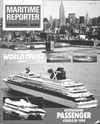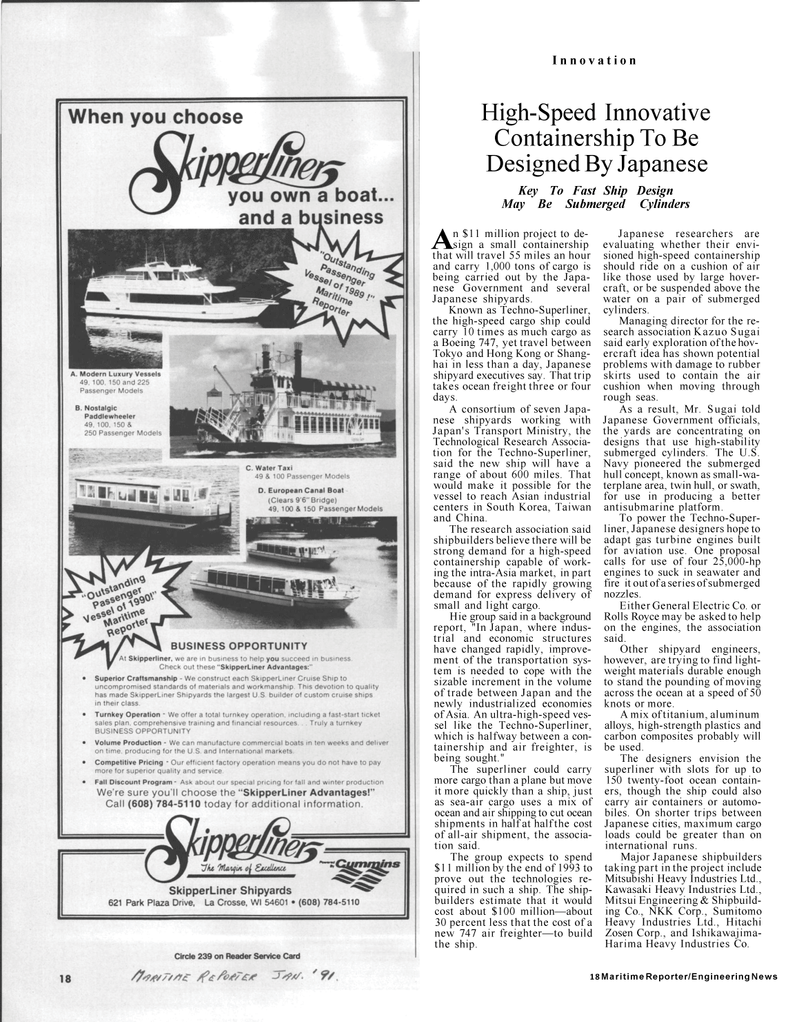
Page 16: of Maritime Reporter Magazine (January 1991)
Read this page in Pdf, Flash or Html5 edition of January 1991 Maritime Reporter Magazine
Innovation
High-Speed Innovative
Containership To Be
Designed By Japanese
Key To Fast Ship Design
May Be Submerged Cylinders
An $11 million project to de-sign a small containership that will travel 55 miles an hour and carry 1,000 tons of cargo is being carried out by the Japa- nese Government and several
Japanese shipyards.
Known as Techno-Superliner, the high-speed cargo ship could carry 10 times as much cargo as a Boeing 747, yet travel between
Tokyo and Hong Kong or Shang- hai in less than a day, Japanese shipyard executives say. That trip takes ocean freight three or four days.
A consortium of seven Japa- nese shipyards working with
Japan's Transport Ministry, the
Technological Research Associa- tion for the Techno-Superliner, said the new ship will have a range of about 600 miles. That would make it possible for the vessel to reach Asian industrial centers in South Korea, Taiwan and China.
The research association said shipbuilders believe there will be strong demand for a high-speed containership capable of work- ing the intra-Asia market, in part because of the rapidly growing demand for express delivery of small and light cargo.
Hie group said in a background report, "In Japan, where indus- trial and economic structures have changed rapidly, improve- ment of the transportation sys- tem is needed to cope with the sizable increment in the volume of trade between Japan and the newly industrialized economies of Asia. An ultra-high-speed ves- sel like the Techno-Superliner, which is halfway between a con- tainership and air freighter, is being sought."
The superliner could carry more cargo than a plane but move it more quickly than a ship, just as sea-air cargo uses a mix of ocean and air shipping to cut ocean shipments in half at half the cost of all-air shipment, the associa- tion said.
The group expects to spend $11 million by the end of 1993 to prove out the technologies re- quired in such a ship. The ship- builders estimate that it would cost about $100 million—about 30 percent less that the cost of a new 747 air freighter—to build the ship.
Japanese researchers are evaluating whether their envi- sioned high-speed containership should ride on a cushion of air like those used by large hover- craft, or be suspended above the water on a pair of submerged cylinders.
Managing director for the re- search association Kazuo Sugai said early exploration of the hov- ercraft idea has shown potential problems with damage to rubber skirts used to contain the air cushion when moving through rough seas.
As a result, Mr. Sugai told
Japanese Government officials, the yards are concentrating on designs that use high-stability submerged cylinders. The U.S.
Navy pioneered the submerged hull concept, known as small-wa- terplane area, twin hull, or swath, for use in producing a better antisubmarine platform.
To power the Techno-Super- liner, Japanese designers hope to adapt gas turbine engines built for aviation use. One proposal calls for use of four 25,000-hp engines to suck in seawater and fire it out of a series of submerged nozzles.
Either General Electric Co. or
Rolls Royce may be asked to help on the engines, the association said.
Other shipyard engineers, however, are trying to find light- weight materials durable enough to stand the pounding of moving across the ocean at a speed of 50 knots or more.
A mix of titanium, aluminum alloys, high-strength plastics and carbon composites probably will be used.
The designers envision the superliner with slots for up to 150 twenty-foot ocean contain- ers, though the ship could also carry air containers or automo- biles. On shorter trips between
Japanese cities, maximum cargo loads could be greater than on international runs.
Major Japanese shipbuilders taking part in the project include
Mitsubishi Heavy Industries Ltd.,
Kawasaki Heavy Industries Ltd.,
Mitsui Engineering & Shipbuild- ing Co., NKK Corp., Sumitomo
Heavy Industries Ltd., Hitachi
Zosen Corp., and Ishikawajima-
Harima Heavy Industries Co. 18 Maritime Reporter/Engineering News

 15
15

 17
17
